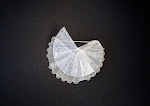
Shelton Walsmith was kind enough to allow me to work from his paintings and explore enamelling techniques. In doing so I fell in love with a shape of his ... I call it the bulbous clover.
Shelton sent through an amazing email on color which I have included below. I displayed it along with pictures of Shelton's work and my color experiments.

Family von bulous


Shelton Walsmith on color:
_________________________________________________________
good to talk to kristin
i'm amazed at the power of color. it's a long engagement for any artist. thinking always bilingually about color and music is helpful in that i find i can build rhymes +couplets from a series of repeated chords and colorings. that thereare only a few to work with at a time is not a curse but a blessingof focus. diversity and variety are born in a myriad of shades shifting amidst the limited palate. i've never thought for a moment "this my color theory", ever. color has its own humor to tell you if its funny or sexy or not. i find fluency in certain color combinations, from there i'm liberated to struggle with image or the figure that inhabits the color field. the figure may be a rectangular letter slot or it may be an ear of corn, it doesnt matter as long as the color is singing and continues tosing with revisits.
one simple experiment i want you to take away from this is a tried and true technique of smoky glazes. these sfumato washes are used by everyone from leonardo da vinci to ross bleckner. paint an oil painting and let her dry......when shes dry to the touch, nothing comes off on your fingers, then take black oil paint thinned down toa transparent wash (test it on newsprint you should be able to readthru it) coat the painting with this substance. what occurs is that darks of the painting darken deeper and the overall tonal intensityis subdued. if your painting has a built up impasto the texture is enhanced in the thickened paint by the wash, an increased shading is apparent in raised surfaces. you can leave this as the final face of the painting or further enrich and re-intensify contrasts and separations with a finishing varnish or you can use the smoked, toned down painting as a point from which to continue painting. i think light is color's greatest gift imparted, light is sacred or profane with illuminates or expoits.
carry the day by having practically no illusory depth or picture.this most apparent when paint is trowelled on as it would be en masse to a wall.in terms of illusion the mastery of color is first a command of tone and tone has its own mastery over the maker and the viewer's emotional response. as tone shifts the viewer experiences emotional resonance rising and falling like musical notes shifting from elated ascending majors to inward plummeting minors. so color is an opportunity to sustain light and life in the wet eyes of the painting due to these affects of tone and to the face + fabric of the surface. this is only a fraction of the knowable portents of color, with billions of shades the total effect is unfathomable. picasso liked to look at his own work and the work of others via black and white reproduction because, he said, he could see the structure better. color in this case is merely so much make up to draftsmen and sculptors of form and space; a can of something you slap on after the real work is done!
more soon,
sw



